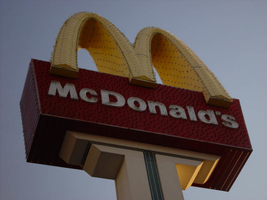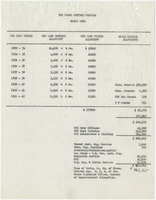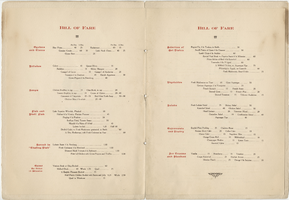Search the Special Collections and Archives Portal
Search Results

Photographs of McDonald's sign, 2800 S Las Vegas Blvd, Las Vegas (Nev.), 2002
Date
Archival Collection
Description
Site address: 2800 S Las Vegas Blvd
Sign details: Located just south of the Westward Ho's south parking lot is the third and northern most version of the sign. Unlike its other two relatives, this sign is solely designated to the McDonald's establishment. It is located in a small landscaped area directly east of the front of the restaurant. This section essentially comprises the front of the establishment itself. It stands tall on the west side of the strip facing north south.
Sign condition: Structure 5 Surface 4 Lighting 4 It is noted that the structural integrity is intact. Certain elements of lighting are out or not working but still present. The surface appears to be slightly deteriorating at this point.
Sign form: Pylon
Sign-specific description: The odd member of the three McDonald's pylons is different in almost every aspect, considering the similarity of the first two to each other. The sign construction itself is a more sleek, opting to integrate the entire structure into a much smoother design than the previous design as well. The other two cabinets are impressive indeed, but the placement of the cabinets is less clumsy than the others. The pole itself is thinner, painted brown steel flat post, which rises into the air, recording a small rectangular anomaly in the vertical line, which is used to support a yellow plastic internally lit cabinet. The four-sided shape swells out on each side, but transitions smoothly as the vertical shot continues upward. The brown post T's off to either side actually stretching to the widest point of the sign. It then grows vertically once again to create the sides of the cabinet. The shape that the brown portion creates is now more akin to a "U" shape rather than a "T." The entire surface of the pylon which is designated brown in laced with incandescent bulbs. Inside this U shape the face of the cabinet is designated red, and set higher above the surface plain of the face. The red fluted steel face is adorned with vertical neon bars and white channel letters floating above the surface. The channel letters are filled with bars of white neon. The giant golden arches break up the top edge of the red cabinet. The arches themselves are yellow painted steel, whose face are encrusted with yellow incandescent bulbs as well as border of yellow neon which floats around the edge of the arch. The tops and bottom surfaces are finished in a reflective, gold, polished metal. A channel runs up the center of the post and a yellow tube of neon glows as a centering stripe. This stripe actually ties in the internally lit yellow sign, with the crowning arches, quite well.
Sign - type of display: Neon; Incandescent; Backlit
Sign - media: Steel; Plastic
Sign - non-neon treatments: Paint
Sign animation: Oscillating, flashing
Notes: The white incandescent bulbs on the face of the sign illuminate in a chasing pattern from bottom to top, leaving all the bulbs illuminated in it's path, oscillating as they are illuminated. The post vertically illuminates, and when the bulbs reach the top of the brown arms of the U shape, the vertical, red, neon bars on the red portion of the cabinet, chase in simultaneously from either side. They meet in the middle leaving all the bars and thus the cabinet fully illuminated. The cabinet stays lit for a few moments, then the bars curtain out from the middle, back to either side, leaving the bars dark in the animations path. Once they reach the edge, the incandescent bulbs follow suit, and chase back down to the bottom, leaving all the bulbs dark it the chasing path. The yellow incandescent bulbs, which are on the face of the golden arches, constantly oscillate during the animations sequence.
Sign environment: As compared to the other two properties, the environment of this McDonald's is quite different. The other two were integrated into the strip mall design, utilizing the pylon itself for other advertisements as well. Even though the McDonald's pylon stood out as the dominant figure among their surroundings, They still felt as if they were part of a whole as well. The environment, which the northern pylon portrays, also reflects its surroundings as well. This environment of the Westward Ho, the Stardust, the Riviera, and the Circus Circus, bring about a certain garish nature in its design that fits in present in the McDonald's pylon.( see artistic significance and theme for further).
Sign manufacturer: YESCO
Sign - thematic influences: The theme of the McDonald's establishment is in the realm of the well-established McDonalds corporation. The golden arches, and solid red hue, have become synonymous with the name "McDonald's," and is an image, which has been communicated to the masses of people for half a century. It is an icon that is associated with America all over the world. McDonalds has created it's own realm and thematic influence over the years from all of it's extensive advertisements and marketing. Therefore, the theme of the establishment's signs draws from itself and the world, which the name has created. Being one of the most commonly seen images in America, this sign is tailored to fit into the illustrious, illuminative properties held on the Las Vegas Strip. It fits into the category of everyday images and businesses dressed up for Las Vegas, which include, Arabia's, Arco AM/PM, Walgreen's, and Fatburger.
Sign - artistic significance: Besides what is mentioned in the above paragraph about the above nature of the iconography of the said logo, this particular sign draws off of its surroundings to display certain aesthetic elements.
Surveyor: Joshua Cannaday
Survey - date completed: 2002
Sign keywords: Oscillating; Flashing; Pylon; Neon; Incandescent; Backlit; Steel; Plastic; Paint
Mixed Content

Amanda "Alex" Aikens oral history interview: transcript
Date
Archival Collection
Description
Oral history interview with Amanda "Alex" Aikens conducted by Barbara Tabach on December 28, 2017 for the Remembering 1 October Oral History Project. In this interview, Aikens discusses the support she provided for the community after the October 1, 2017 shooting in Las Vegas, Nevada along with the event at First Friday that she organized to provide counseling services for those in need. She describes her usage of Facebook as a social media platform to keep the community posted on the shooting as well as any advice and resources for those who wanted to help. Aikens expands upon her realization that people felt the need to contribute and discusses her efforts to gather a group of therapy volunteers that eventually grew so large an event space was needed. In addition to the volunteers who provided counseling and other event functions, she mentions a few of the companies that made the event possible with a donation of resources, such as First Friday that offered room space and a nearby office that supplied furniture.
Text

Report, The flood control program - Moapa area, after 1942
Date
Archival Collection
Description
Cost of Civilian Conservation Corp work in the Moapa Valley and the benefits accrued to the residents of the valley.
Text

Las Vegas water supply in 1936, circa 1937
Date
Archival Collection
Description
Report of the output of the Las Vegas Springs and well, and Las Vegas water consumption for 1936.
Transcribed Notes: handwritten corrections in pencil
Text
UNLV University Libraries Collection on Techatticup Mine
Identifier
Abstract
The UNLV University Libraries Collection on Techatticup Mine (1914-1923) is comprised of administrative and financial records associated with the Techatticup Mine, located in Clark County, Nevada south of Nelson, Nevada. The administrative documents include business reports, prospectuses, and assays. Administrative documents also include foreman reports, insurance records, warehouse inventories, correspondence, and notes relating to equipment, food, employment, and taxes. Financial records include account balances, payroll, purchasing records, statements, bills, receipts, and company vouchers.
Archival Collection
Kenneth Giles Professional Papers
Identifier
Abstract
The Kenneth Giles Professional Papers (1964-2001) contain documents and visual material related to Giles's time as an Environmental Radiation Monitor for the Environmental Protection Agency (EPA) at the Nevada Test Site (NTS). Photographic slides, film, and digital images depict the general flora and fauna throughout the area surrounding the NTS. Visual materials also document specific mule deer and steer surveillance and testing at the EPA Farm located within the NTS. The collection also contains environmental reports written or collected by Giles, government documents, pamphlets, and newspaper clippings related to environmental monitoring and Giles's work at NTS. A small portion of the collection documents his brief role providing monitoring support at Three Mile Island in Pennsylvania in 1979. Note: Some images may be of a graphic or disturbing nature and may not be suitable for some users. Photographs may contain scenes of animal testing or other objectionable imagery.
Archival Collection
UNLV History 117: Nevada History Photograph Collection
Identifier
Abstract
The UNLV History 117: Nevada History Photograph Collection contains photographic prints, negatives, and slides of Las Vegas and Boulder City, Nevada between approximately 1900 and 1959. These images were collected by students for University of Nevada, Las Vegas (UNLV) professor Ralph Roske’s class, History 117: Nevada History. The images primarily depict Las Vegas in the 1950s with people posing in front of and inside the El Rancho Vegas and the Last Frontier Village, including Eleanor Roosevelt, Joe E. Lewis, and Paul Newman. Earlier photographs from the 1920s include businesses, such as fireproofing stores, and significant individuals such as Ed W. Clark. Lastly, it contains two photographs of the Boulder City Airport.
Archival Collection
Cliff Trenier Papers
Identifier
Abstract
The Cliff Trenier Papers (approximately 1950-1999) document the life and career of Clifton "Cliff" Trenier, who performed with various siblings across the United States beginning in the 1940s. The collection contains photographs of Cliff with his twin brother Claude performing, documents and newspaper clippings relating to the musical group's tours and their numerous performances in Las Vegas, Nevada including at the Moulin Rouge. Also included in the collection are photographs of Cliff's wife, Bedez, and correspondence between the couple up until Cliff's illness and death in 1983.
Archival Collection
Maria LaCavera Papers
Identifier
Abstract
The Maria LaCavera Papers (1947-2017) contain the papers of professional dancer Maria LaCavera. The collection documents the career of LaCavera dancing in Las Vegas, Nevada at the Flamingo Hotel in 1947, and the Last Frontier Hotel in 1949 as one of the Ramona Girls dancing in the Danny O'Neil Varieties Act. Materials include photographs of LaCavera and other Ramona Girls, newspaper clippings, correspondence, LaCavera's American Guild of Variety Artists (AGVA) employment contracts, Fabulous Las Vegas magazines, and hotel receipts. Other items of note include photographs of the 1949 Helldorado parade, a Frontier Hotel Ramona Room menu, and Frontier Hotel ephemera. There is also a copy of a self-published biography of LaCavera, written by her daughter-in-law Kristin Meyer entitled From Bon-Air to the Last Frontier. The collection also contains the digital images used to illustrate the book.
Archival Collection

